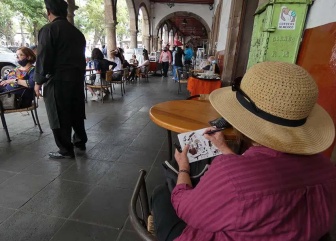Expat artist’s sketching lets her discover the Mexico around her
News Category: News, Art News, Community News, and General Discussion
-
“Most people kind of get the basics of learning to draw and see it almost like an addiction,” says Susan Dorf, an urban sketcher and art teacher in Pátzcuaro, Michoacán. “When you’re sketching, you drop into that deeper place which is sort of meditative.”
Dorf has been meditating and sketching in Mexico for the last 10 years, and it has meant a whole new palate and landscape.
“I like to see what’s up close, what’s far away, how can I bring that all together,” she says describing Mexican markets, whose swirling movement and vibrancy inspire her work. “I like to be in the middle of life and what’s happening.”
Dorf has been teaching sketching, drawing, and painting for 12 years, and she’s learned that the hardest thing to get over when you start to draw is, basically, yourself.
“The main thing to overcome is judgment and fear,” she says, “So, when I can get people into a place where they can be neutral, so that not only are they not feeling judged or criticized but I’m also not praising them either, there’s a sense of not having to live up to anything.”

“If it’s perspective or scale, it’s all the same; it’s learning to see — you are basically exercising your eye and your mind and your hand to coordinate. And if you’ve not done that, it’s really awkward, but if you practice, you get more comfortable. You’re learning how to see things in a way that is different from just glancing at them or recording a symbol of it. You’re slowing down to really see it.”
Dorf is a believer in sketching the landscape around her and the people in it: when she lived in San Miguel de Allende, she was a constant fixture, recording life in a city that is both very traditional and yet also changing rapidly due to the near-constant demand for new construction.
She even got a gig doing urban sketching for the local weekly newspaper, Atención San Miguel, a job which continues today even though she no longer lives in the city.
People have always drawn, from cave walls to prestigious art schools, but the current Urban Sketchers movement that Dorf is part of was started in 2007 by Spanish journalist Gabriel Campanario, who started sharing his drawings online.
In 2009, Campanario formed the Urban Sketchers International nonprofit, a group that unites sketchers all over the world and that offers “chapter” affiliation for groups like the one that exists in San Miguel de Allende.
Dorf’s teaching helped to form the chapter, and many current group members have taken her workshops.
In Dorf’s experience, urban sketching seems to have a particular draw for middle-aged people and retirees; her students are often recent empty nesters or older ex-pats. Urban Sketcher group members meet up to sketch where they live or sometimes travel together and sketch on the road – it’s an easy hobby to take with you wherever you go.

“It’s a phenomenon really, it just kind of became that, because it’s so portable. When I go out, I have this little bag and it fits in my purse or my day pack, and when people are traveling, it’s the perfect thing,”
For someone like Dorf, who loves movement and life (she often sketched parades and protests in San Miguel), COVID restrictions completely changed her drawing life.
Fewer people out and about, as well as ubiquitous face mask requirements, meant she turned to sketching architecture and nature and found herself taking long walks alone to sketch the city as it slumbered in quarantine.
These days, you can find Dorf in her new home, Pátzcuaro, Michoacán, and as COVID restrictions ease, she’s teaching sketching once again to visitors and locals there. Her sketches can still be found printed in Atención San Miguel, and she’s recently published a book of her work.
Her newest plans involve sketching local artisans.
“Every village kind of has its own craft, and I’m interested in going to visit them and doing little drawings of them — writing about them and doing this kind of graphic reportage pieces about the people who are here.”

For Dorf, sketching is a way to both be part of the action of a scene and yet keep a kind of journalist’s distance, allowing sketchers to be both participant and archivist. And if you think that after years of teaching and creating, sketching would lose this transformative force, Dorf insists that the experience is always fresh, no matter what the scene.
“As soon as I feel that I’ve got [something] down, then I am going to throw a wrench in the works and make it more difficult,” she adds with a laugh.
-


Leave a Reply